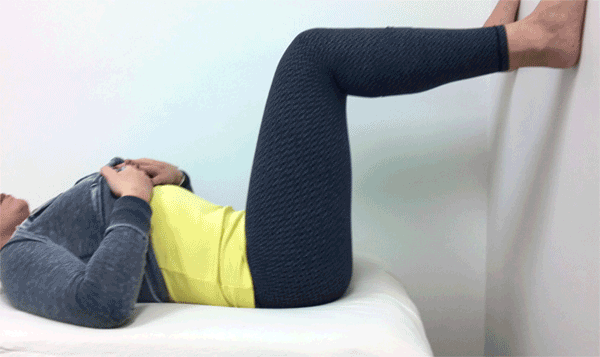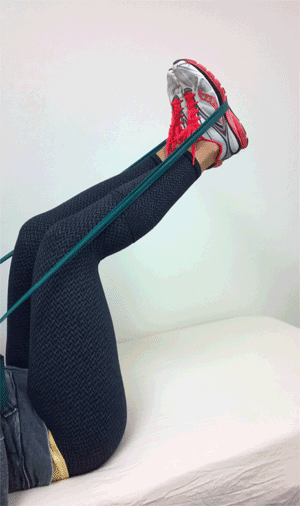New Strengthening Exercises X
Wall Bridges With Pelvic Tilt

The exerciser lies on his back with the bottoms of his feet flat against the wall and knees bent 90 degrees. The value of this position is greatest for those susceptible to low back spasms because it eliminates the danger of lumbar hyperextension (arching the back) which makes traditional bridges so risky. The movement is a 5-part with each part done for 1 second:
Part 1 - The exerciser tightens his buttocks and abdomen to assist in pushing the lower back downward toward the floor (pelvic tilt). This position is held throughout the parts 1 through 4.
Part 2 - The pelvis is elevated slightly off the floor.
Part 3 - The pelvis is elevated further.
Part 4 - The pelvis is elevated maximally while continuing the pelvic tilt. Some exercisers can hold this much longer than one second if they feel able.
Part 5 - The pelvis is returned to the floor for a 1 second rest before repeating the above.
The exercise is repeated to fatigue and done 1 to 3 times per day.
Structures strengthened:
Abdominals
Gluteal muscles
Thigh quadriceps muscles
Band Bicycle Pedaling

The exerciser lies on his back with knees bent toward chest. He grasps the ends of the band in each hand and hooks the center portion of the band under the soles of his feet. Next, he begins a pedaling action by pushing one foot forward while simultaneously pulling the other slightly backward, then repeating this movement with the opposite foot in an alternating manner in rapid succession like pedaling a bicycle. The exerciser is careful not to make the motions too large so that he avoids losing control of the band. The pedaling action is continued until the legs are fully fatigued. This one set is done one to three times daily.
Structures strengthened:
Leg quadriceps muscles
Patellar tendon
Ankle stabilizers
Return to the Articles Page
Return to the Where's Your Pain? Page



